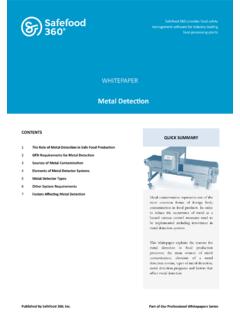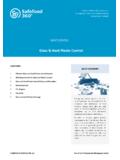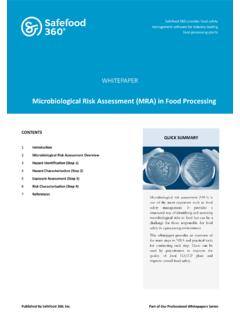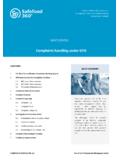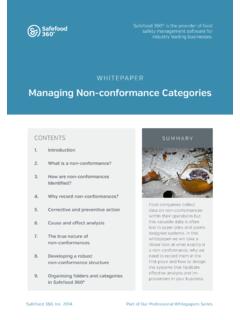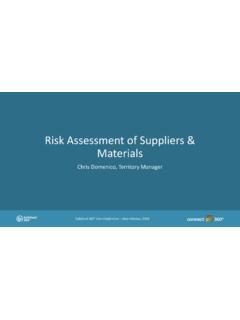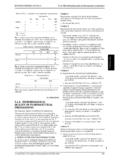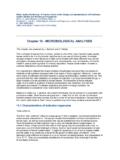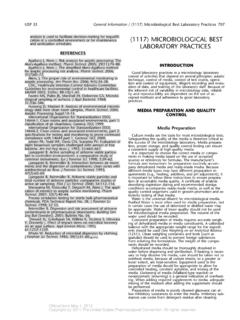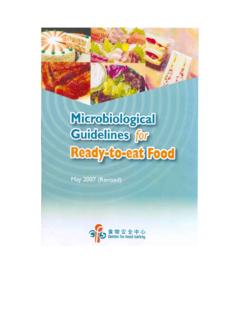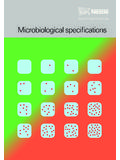Transcription of Microbiological Risk Assessment (MRA) in Food …
1 Safefood 360 provides food safety management software for industry leading food processing plants WHITEPAPER QUICK SUMMARY Published by Safefood 360, Inc. Part of Our Professional Whitepapers Series Microbiological risk Assessment (MRA) is one of the most important tools in food safety management. It provides a structured way of identifying and assessing Microbiological risks in food but can be a challenge for those responsible for food safety in a processing environment. This whitepaper provides an overview of the main steps in MRA and practical tools for conducting each step.
2 These can be used by practitioners to improve the quality of local HACCP plans and improve overall food safety. CONTENTS 1 Introduction 2 Microbiological Risk Assessment Overview 3 Hazard Identification (Step 1) 4 Hazard Characterisation (Step 2) 5 Exposure Assessment (Step 3) 6 Risk Characterisation (Step 4) 7 References Microbiological Risk Assessment (MRA) in Food Processing Microbial Risk Assessment (MRA) in Food Processing Safefood 360 Whitepaper (August, 2012) Throughout food safety management standards Risk Assessment (RA)
3 Has become the core tool required to determine the scope and nature of specific food safety controls and programs. From HACCP to pest control, companies are now required to conduct an Assessment of risk to support and justify their food safety management system. Yet it is widely believed that the skills and knowledge necessary to conduct such risk assessments may not exist in the majority of food busi-nesses. In the GFSI series of standards, recent revisions have seen the requirement for conducting risk Assessment increase dramatically.
4 How these risk assessments should be conducted and to what extent has not been highlighted, leaving a wide gap for local interpretation. The value of risk as-sessment is generally accepted. It is a scientific and analytical process or tool that requires various factors to be assessed before deciding on the significance of a particular hazard. This has the bene-fit of ensuring that the resources in a food processing operation can be focused on the areas of greatest importance for food safety. However, its effective use requires knowledge of the principles and practices of RA and good quality data to drive valid decisions.
5 In the world of food safety, mi-crobiological hazards represent the greatest risk in terms of poor consumer outcomes when an outbreak occurs. On the serious end of the scale these incidents often result in widespread illness, hospitalizations, chronic medical conditions and deaths. In this whitepaper, we will cover the specific area of Microbiological Risk Assessment (MRA) and provide workable tools to assist you in better determining the risks associated with Microbiological hazards. This should drive better and more robust HACCP planning within your plant.
6 It is not intended to address all the areas of MRA (which is a vast subject) but rather to cover the general principles and provide some workable tools for their application. Those responsible for the implementation and maintenance of food safety plans in processing plants are frequently preoccupied with questions such as how best to identify hazards, how to de-termine whether hazards are important or significant and where to find information on hazards? In particular, Microbiological hazards present the most difficulty since many food safety managers with the responsibility of hazard analysis and HACCP planning are not microbiologists and when they find information on the subject, may not always be in the position to interpret it correctly.
7 The evolution of risk based food safety systems such as HACCP have played a major role in pro-tecting public health and underpinning our efforts in a structured and scientific way. However, the practical impact on those in our industry who are required to develop these systems is significant and often characterised by what we don t know rather than what we do. There is a documented case were a food business producing salami products decided to develop a snack version which was smaller and had a higher mass to surface area ratio. The product dried out faster, water activity fell faster and acidification was incomplete.
8 This gave rise to favourable conditions for Salmonella growth and resulted in a market recall. Microbial Risk Assessment (MRA) in Food Processing Safefood 360 Whitepaper (August, 2012) The case highlights the difficulty with Microbiological risk Assessment as part of HACCP. The sim-ple act of producing a smaller version of the same product led to a Microbiological hazard that pre-viously did not exist. It also indicates the knowledge required to conduct proper hazard identifica-tion. Much has been written on the subject by experts trying to understand why HACCP plans fail and lead to recalls.
9 Research reviewed by Kane, Mayes & Mortimore identified poor hazard identifica-tion and hazard analysis as a significant reason. So how do we conduct Microbiological risk assess-ment in food processing plants? How do we ensure that our risk assessments are robust enough to support our HACCP plans and reduce the chances of product failures? In this whitepaper you will find practical support and resources for conducting MRA. It is not an easy topic to address, yet it is an essential part of what we do as people responsible for food safety.
10 There are four main steps in conducting a Microbiological Risk Assessment : Hazard Identification Hazard Characterisation Exposure Assessment Risk Characterisation These steps have been defined by bodies such as the WHO/FAO and bearing in mind that no food processing plant has the massive resources of these bodies, we can use simple tools to con-duct a good quality MRA depending upon the complexity of your products and processes. This is the first step in conducting Microbiological risk Assessment and perhaps the most important since if you don t identify the hazards correctly no amount of subsequent HACCP planning will make your product safe.
